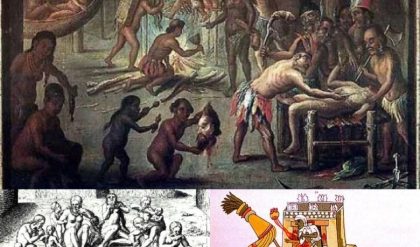The Aztec civilization, a vibrant and complex society that flourished in pre-Columbian Mesoamerica, is often shrouded in misconceptions and sensationalized portrayals. One of the most enduring and disturbing aspects of Aztec culture is the practice of cannibalism. While the consumption of human flesh may seem barbaric and abhorrent to modern sensibilities, it is crucial to understand this practice within the context of Aztec beliefs, rituals, and worldview.

The Role of Cannibalism in Aztec Society
Cannibalism among the Aztecs was not merely a dietary choice or an act of desperation driven by food scarcity. Rather, it was deeply embedded in their religious and cosmological beliefs. The Aztecs believed that the gods required sustenance, and human flesh, particularly that of sacrificial victims, was considered the most potent form of nourishment. This act of cannibalism was seen as a way to honor the gods, ensure their continued favor, and maintain cosmic balance.

Ritualistic Feasts and the Consumption of Sacrificial Victims
Aztec cannibalism was primarily associated with sacrificial ceremonies, particularly those involving prisoners of war or individuals deemed worthy of offering to the gods. Following the ritual sacrifice, the bodies of the victims were not simply discarded but were carefully prepared and consumed during elaborate feasts. These ceremonial banquets were attended by priests, nobles, and warriors, and the consumption of human flesh was believed to confer spiritual power and strength upon the participants.

The Symbolic Significance of Cannibalism
Beyond its religious and nutritional implications, cannibalism held profound symbolic significance for the Aztecs. It represented the cyclical nature of life and death, the interconnectedness of all beings, and the ultimate sacrifice made to appease the gods and ensure cosmic harmony. The act of consuming human flesh was seen as a way to bridge the divide between the physical and spiritual realms, allowing the Aztecs to connect with the divine and participate in the cosmic order.

Archaeological Evidence and the Debate Surrounding Aztec Cannibalism
The practice of cannibalism among the Aztecs is supported by various archaeological findings, including skeletal remains with cut marks and evidence of cooking, as well as depictions of cannibalistic rituals in Aztec codices and sculptures. However, the extent and frequency of cannibalism in Aztec society remain a subject of debate among scholars. Some argue that cannibalism was a relatively rare occurrence, limited to specific rituals and social groups, while others suggest that it was more widespread and played a more significant role in Aztec culture.

While the practice of cannibalism may seem abhorrent to modern society, it is essential to approach it with understanding and contextualization. For the Aztecs, it was not a mere act of savagery but a deeply meaningful and integrated aspect of their religious beliefs, worldview, and social practices. By examining cannibalism within its cultural context, we can gain a more nuanced and accurate appreciation of the complexities and contradictions of Aztec civilization.

The Aztecs distinguished between “sacred cannibalism” associated with sacrificial rituals and “secular cannibalism” involving the consumption of fallen enemies or individuals deemed to have committed certain transgressions.

The practice of cannibalism was not unique to the Aztecs but was found in various cultures throughout Mesoamerica and other parts of the world.

The Spanish conquistadors, upon encountering Aztec cannibalism, used it as propaganda to justify their conquest and portray the Aztecs as barbaric and uncivilized.






